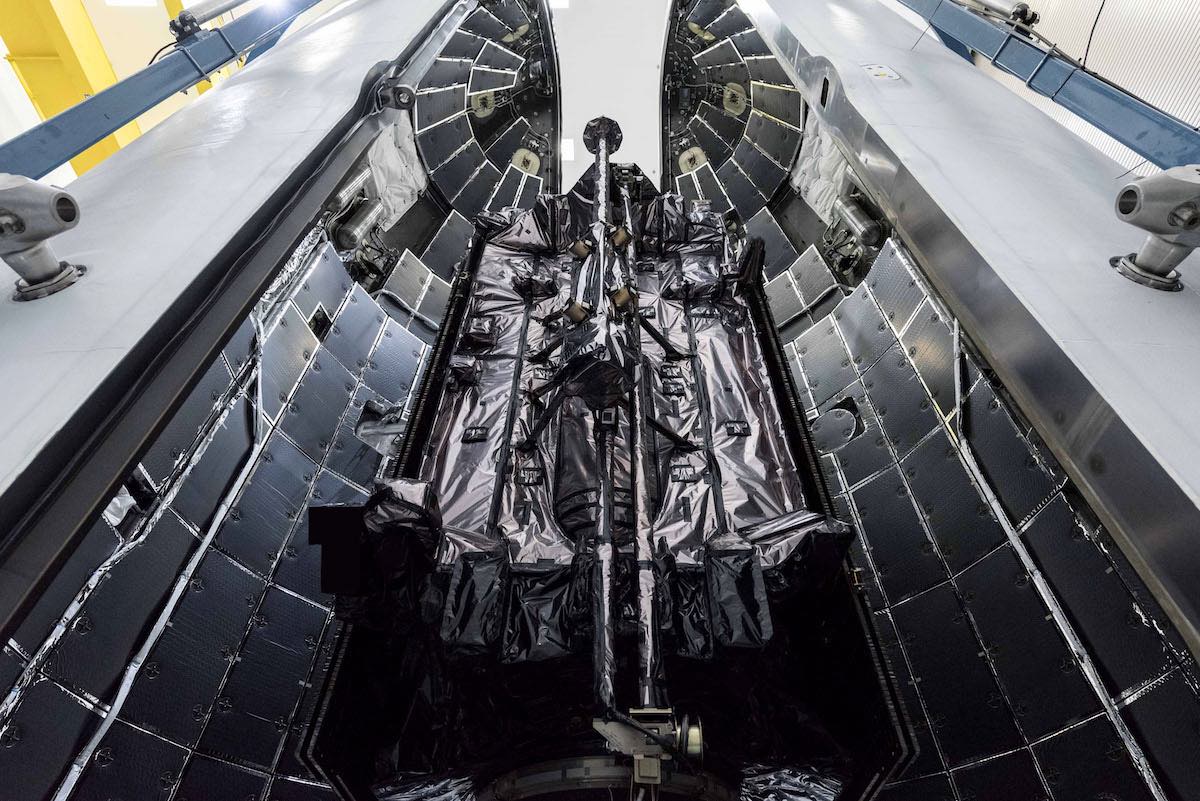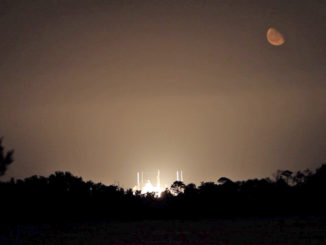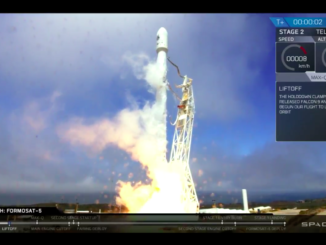
SpaceX test-fired a Falcon 9 rocket at Cape Canaveral on Saturday in a pre-flight checkout designed to verify the launcher’s engines are ready to loft a U.S. military GPS navigation satellite into orbit Nov. 5.
An engine problem forced SpaceX to abort a launch attempt in early October.
After identifying the issue, SpaceX test-fired the Falcon 9 rocket for the GPS mission again Saturday at 7 p.m. EDT (2300 GMT) on pad 40 at Cape Canaveral Air Force Station. The test was intended to verify corrective actions have resolved the issue.
SpaceX rolled the two-stage rocket — without its GPS navigation satellite payload — to pad 40 and raised the Falcon 9 vertical Saturday. The launch team stationed in a nearby control center oversaw loading of kerosene and liquid-oxygen propellants into the rocket Saturday evening ahead of the 7 p.m. test-firing.
The rocket’s nine Merlin 1D engines ignited with a flash and a rumble across the Cape Canaveral spaceport. The engines fired for several seconds, ramping up to 1.7 million pounds of thrust as hold-down clamps kept the Falcon 9 firmly on the ground.
SpaceX later confirmed in a tweet that the test-firing was completed, setting the stage for final launch preparations. The mission is scheduled to lift off Thursday, Nov. 5, SpaceX wrote in a tweet.
The mission had previously been scheduled to launch as soon as Wednesday, according to multiple sources.
The Falcon 9 rocket will be rolled back to its hangar, where SpaceX will mount the U.S. Space Force’s GPS 3 SV04 navigation satellite onto the vehicle. The spacecraft is already encapsulated inside the Falcon 9’s payload shroud.
The GPS 3 SV04 mission was ready to take off Oct. 2, but SpaceX halted the countdown at the start of the engine ignition sequence just two seconds prior to liftoff.
Engineers investigating the Oct. 2 abort found that two of the engines on the rocket had a tendency to ignite a split-second earlier than expected. Inspections showed a blocked relief valve in the gas generators of the two engines caused pressures to rise sooner than designed at startup, and sensors on the engines detected the problem and halted the countdown.
SpaceX presumably has replaced the two suspect engines on the Falcon 9 rocket. A Space Force spokesperson referred inquiries to SpaceX, and a SpaceX spokesperson did not respond to questions on the matter.

The Lockheed Martin-built GPS 3 SV04 navigation satellite is the fourth in a new generation of GPS satellites with longer lifetimes, higher power, and more accurate navigation signals. The GPS 3 SV04 spacecraft is set to join 31 operational GPS satellites in orbit 12,550 miles (20,200 kilometers) above Earth.
SpaceX engineers identified a masking treatment inadvertently left behind in two Merlin engines as the cause of the Oct. 2 abort.
“When we looked at the data, we saw that two of the engines attempted to start early, and the auto abort prevented that,” said Hans Koenigsmann, SpaceX’s vice president of build and flight reliability. “And by doing that, it prevented a possible hard start that could have been damaging to the engine hardware.”
The Merlin engines power up with help from an igniter fluid known as TEA-TEB — or triethylaluminium-triethylborane — that gives off a bright green flash at the start pf the ignition sequence.
“And then we have liquid oxygen, and we have kerosene, or RP-1 as its called,” Koenigsmann said last week in a conference call with reporters. “And you need to introduce these liquids in the right order. If you do this in the wrong order, if you happen to throw in the liquid oxygen and the RP-1 and the igniter fluid, then what would happen is we call it a hard start.”
A hard start would “rattle” the engine in most cases, but could cause damage, Koenigsmann said. “So in general, you do not want that. You want a good startup.”
“If we see the pressure rise too early, then we know liquid is in there, and it shouldn’t be there,” he said. “And software in the engine controller then stops the whole process.”
Inspections at the launch pad uncovered no sign of a hardware problem on the Merlin engines after the Oct. 2 abort. After returning the Falcon 9 rocket to its hangar, technicians removed the engines and shipped them to SpaceX’s test facility in McGregor, Texas.
SpaceX was able to analyze the engines’ startup behavior in McGregor, and additional inspections found a blockage in a narrow line leading to a relief valve on the gas generator.
Koenigsmann said the vent port, which means just one-sixteenth of an inch wide, was obstructed by a hardened masking lacquer. He said liquid lacquer — similar to red nail polish — is used by a third-party vendor that anodizes aluminum engine components for SpaceX.
The lacquer protects certain parts during the anodizing treatment process, but the vendor — which officials did not identify — is supposed remove the material before shipping the components to SpaceX for engine manufacturing.
The gas generator on each Merlin engine drives a turbopump feeding kerosene and liquid oxygen propellants into the main combustion chamber.
“It’s obviously a very important part,” Koenigsmann said. “That little red substance was blocking a relief valve that caused it to (ramp up pressure) a little bit earlier than it was supposed to.”
“Probably during the washing or the cleaning process some of that masking lacquer went into this vent hole and blocked it,” Koenigsmann said.
“How was this missed? The little borehole that goes to the vent valve is tiny. It’s 60 thousandths of an inch … When something goes in there and is hung in there, it’s possible you miss it,” Koenigsmann said. “You shouldn’t … but I can see how people overlook that and didn’t quite see that, even if it is red.”
Engineers at SpaceX’s McGregor test site also demonstrated that the engines performed normally after removing the blockage from the vent valve. Koenigsmann said the issue was “very subtle, but can have obviously some negative impact on the engine operation.”
“No question that rocketry is tough and requires a lot of attention to detail,” Koenigsmann said. “To me, this almost tells me that rockets are humbling me every day I work with them. It’s always a challenge, and it’s always difficult, and you have to be super diligent and on your toes to get this right.”
SpaceX engineers had not detected the problem before. Older boosters in SpaceX’s fleet of reusable Falcon 9 rockets seem to not exhibit early ignition data signature, but the rockets for the GPS and Crew-1 missions are brand new.
“What we’ve noticed is this is something that must have happened within the last couple of months, so it affects primarily engine build dates that are on new boosters and not on old boosters,” Koenigsmann said.
Besides the rocket for the GPS mission, which will use a new Falcon 9 booster, the engine issue has also affected vehicles for a pair of upcoming NASA launches.
The first operational flight of SpaceX’s Crew Dragon spaceship is set for liftoff Nov. 14 from the Kennedy Space Center with three NASA astronauts and a Japanese mission specialist to kick off a half-year expedition on the International Space Station.
SpaceX is replacing two Merlin engines on the Falcon 9 rocket for the Crew Dragon mission that engineers found suffered from the same early startup tendency exhibited by the engines on the rocket for the GPS mission. The problem delayed the Crew Dragon launch from Oct. 31 to Nov. 14.
A U.S.-European oceanography satellite named Sentinel-6 Michael Freilich was supposed to launch on another brand new Falcon 9 booster Nov. 10 from Vandenberg Air Force Base, California. Kathy Lueders, head of NASA’s human exploration and operations division, said Oct. 30 that the Sentinel-6 Michael Freilich launch would be delayed later into November, “pending ongoing analysis of data from engines.”
Email the author.
Follow Stephen Clark on Twitter: @StephenClark1.



